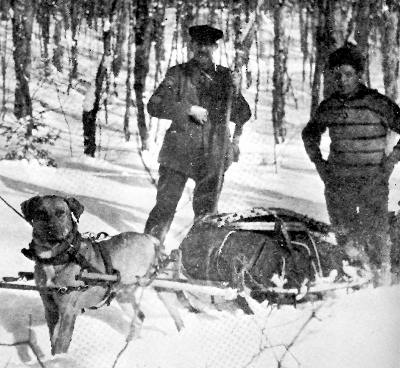 |
February 9, 2007Grey Owl Remembered
|
A hundred years ago this winter 19 year old Englishman
Archie Belaney was learning how to hunt, trap and survive in the forests of
Temiskaming with Bill Guppey’s family. He arrived in Temiskaming the previous
summer as a naïve 18 year old and was taken in by the Guppys. In the spring of
1907 Bill, Archie and Bill’s two brothers headed for the Temagami on snowshoes
looking for work. Bill Guppy wrote a book in 1940 with Hal Pink about his life
and included a fascinating chapter on his experiences with Archie – see
www.ourroots.ca and look for Bill Guppy: King of the Woodsmen. The next
five formative years were crucial to Archie’s development as one of Canada’s
remarkable authors and conservationists. He got to know the people of Bear
Island and married Angele Egwuna and had a daughter Agnes.
 |
Agnes Belaney (right) with friends. Photo from Teme-augama
Anishnabai, Bear Island, Lake Temagami. |
The Angele Project
The W.K.P. Kennedy Art Gallery mounted a powerful major
exhibition on the life of Angele, Agnes and Archie and Agnes Lalonde’s family
last summer. It brought into focus the importance of those five years on
Archie’s development as Grey Owl. The exhibition will come to Temagami this
summer as a part of the recognition of Archie’s arrival 100 years ago this
spring. The Temagami Community Foundation and others are working with the
Kennedy Gallery to present the exhibition centred at the Train Station from June
through September.
Kathy Dwyer Smith and Mac McKenzie are co-chairing the
committee. There are tentative plans for a Grey Owl Play and a reading of one
of Grey Owl’s best known works The Tree as a part of the educational component
of the event.
An Early Archie Adventure
In the winter of 1909 an event took place that epitomizes
the two sides of Archie Belaney – The Adventurous and the courageous sides. The
story is a part of Algonquin Park history and it is told in at least four books
I have looked at.
The Park Management had stopped all trapping in the Park
except that by Park Rangers. This obviously affected the many trappers who
regularly trapped in the Park. Many trappers including natives were caught in
the Park and fined or lost their licence. One such case is told in my book the
Fossmill Story. Archie, who had traveled in the bush as a mail carrier between
Temagami and Temiskaming many times was young and angry and decided to do
something about it.
On a bet he decided to protest the rules and cross the Park
in mid-winter as a challenge to the authorities of the Park. The Park
Superintendent got wind of the challenge and alerted his Rangers. One Ranger
was Mattawa’s Zeph Nadon whose son Maurice was the Commissioner of the RCMP from
1973-1977.
 |
Park Rangers Mark Robinson and Bud Callighan. |
The Rangers stationed themselves on the poaching trails.
Archie was well into the Park and sitting by his fire when Ranger Callighan
arrived. The two men camped the night prior to Archie being charged the next
day at Park Headquarters. Archie woke early and slipped away but did not get
far before breaking through the ice of a beaver pond and getting soaked in the
bitter cold weather. Callighan followed Archie’s trail and saved him with a
warm fire and took him to the Superintendent’s office – Archie’s feet were
frozen and he was not fit to travel. He was cared for for three weeks and given
train fare back to Temagami.
The rangers heard of Archie once again when Tom Thomson
reported seeing him once, years later. The Rangers were well aware of a native
author and lecturer by the name of Grey Owl. Author Audrey Saunders in her
classic Algonquin Story book tells how in 1935 an Indian met one of the Rangers
and said “Grey Owl sends his greetings”. The Ranger was confused until he was
told that Grey Owl was the same man that had been saved in 1909 and that Grey
Owl had remembered.
Archie learned the Ojibway language, hunted, trapped, and
lived the native way of life for the next five years before moving on to
Biscotasing. He married Angele in 1910 and saw her and daughter Agnes on
occasion. In 1925 on one of his rare trips to Temagami visiting Angele and
Agnes he met Gertrude Bernard from Mattawa and she became his muse and mentor as
Anahareo. That story was told in the multi-million dollar Grey Owl movie in
1999. The Angele Project provided a long overdue look at the Temagami period
when the dye was cast for Grey Owl’s remarkable contribution as Canada’s best
known author and conservationist of the 1930s.
Heritage Perspective Home Page
| 
![]() Past
Forward is now on Facebook "LIKE" us to keep in touch
Past
Forward is now on Facebook "LIKE" us to keep in touch